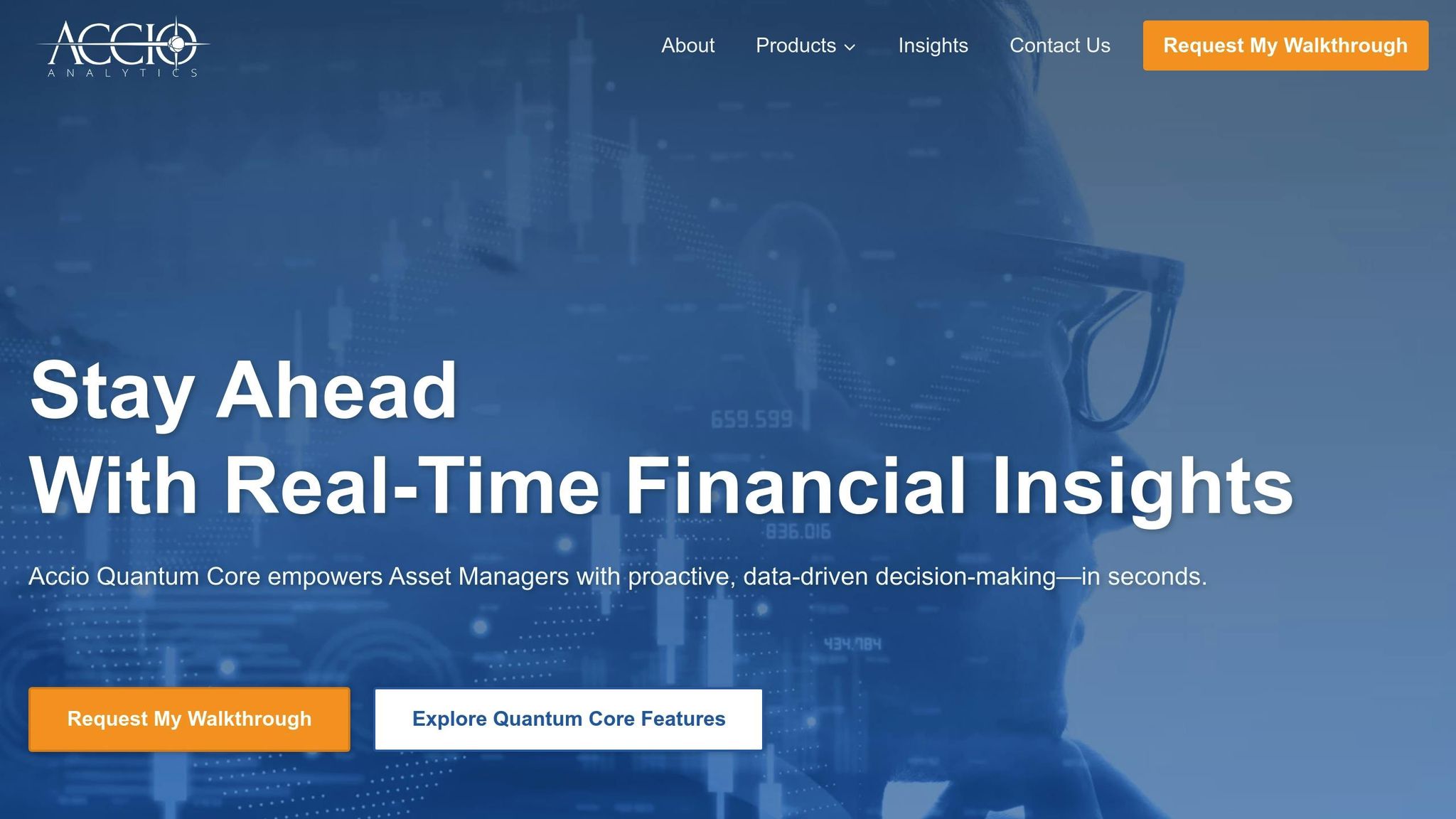AI Volatility Prediction for Risk Management
Accio Analytics Inc.
14 min read
Legacy systems are costing firms more than just time – they’re exposing portfolios to unnecessary risks. Outdated risk models, built on batch processing and siloed data, simply can’t keep up with today’s fast-moving markets. The result? Missed intraday opportunities, delayed responses to market shocks, and increased compliance risks.
AI-powered volatility prediction tools are changing the equation. By processing real-time data streams and continuously refining risk models, these platforms provide early warnings and actionable insights that legacy systems can’t match. For executives, this means safeguarding assets and staying ahead of regulatory expectations. For technical teams, it’s about enabling faster, smarter decision-making.
Key Takeaways:
- Faster Risk Detection: AI analyzes market shifts in seconds, not hours, providing early warnings of potential volatility spikes.
- Real-Time Insights: Continuous updates ensure risk assessments reflect current market conditions, not yesterday’s data.
- Regulatory Readiness: Automated, real-time compliance reporting simplifies audits and reduces regulatory exposure.
- Operational Efficiency: By automating calculations and eliminating manual updates, AI reduces workload and operational costs.
The bottom line? AI isn’t just an upgrade – it’s the solution to managing risk in a volatile, data-driven world. Let’s break down how these systems work and the measurable benefits they deliver.
AI and ML Models for Market Volatility Forecasting – Deep Dives with IIQF Experts – Webinars Series

Problems with Traditional Volatility Prediction Systems
Traditional systems for predicting volatility reveal critical shortcomings in timeliness, compliance, and adaptability. These outdated approaches leave firms exposed to significant risks, particularly during sudden market shifts.
Late Data and Missed Market Moves
One of the most glaring issues with traditional systems is batch processing delays. Many legacy platforms only update risk calculations once or twice a day, usually during overnight processing. This means portfolio managers are often working with outdated risk assessments, even as markets experience rapid intraday changes.
When intraday volatility strikes – sometimes within minutes – these systems fail to capture it until the next update cycle. This creates a dangerous lag, forcing firms to make decisions based on stale information.
Adding to the problem, traditional systems rely on static reports, often in the form of fixed PDFs. These reports can’t be adjusted on the fly, leaving teams dependent on IT support to run new analyses. During periods of high volatility, this rigidity stifles the dynamic decision-making that firms need to stay ahead.
Another issue is the use of separated databases. Legacy systems often store critical data – such as market trends, portfolio holdings, and risk metrics – in disconnected silos. This fragmented structure makes it nearly impossible to gain a comprehensive view of risk, especially when volatility impacts multiple asset classes at once.
All of these factors contribute to data delays that not only hinder real-time decision-making but also increase compliance and business risks.
Business and Compliance Risks
Outdated systems for volatility prediction can also lead to regulatory challenges. Financial regulators, like the SEC, now expect firms to demonstrate real-time risk monitoring capabilities. Batch-processed data, which lacks immediacy, may not hold up under scrutiny during operational resilience examinations.
The consequences of delayed risk detection can be severe. When traditional systems fail to spot emerging volatility patterns, Value-at-Risk (VaR) calculations based on outdated data can underestimate actual exposure. This not only increases the chance of policy violations but also allows risks to accumulate in positions that are deteriorating.
Moreover, decision-making inefficiencies are a constant struggle for firms using legacy platforms. During market stress, C-suite executives need up-to-the-minute insights. However, traditional systems can’t provide dynamic updates, forcing leadership to make critical calls with incomplete or outdated information.
Legacy Systems vs. Modern AI Requirements
The table below highlights the stark contrast between the capabilities of legacy systems and the demands of modern AI-driven tools:
| Capability | Legacy Systems | Modern AI Requirements |
|---|---|---|
| Data Processing | Batch updates (daily/overnight) | Real-time streaming analysis |
| Volatility Detection | Historical pattern matching | Predictive modeling using diverse data sources |
| Response Time | Hours to days | Seconds to minutes |
| Adaptability | Manual model updates | Continuous learning and adjustment |
| Data Integration | Siloed databases | Unified, real-time data streams |
| Scalability | Fixed capacity limits | Dynamic resource allocation |
| Alert Systems | Static threshold warnings | Intelligent, context-aware notifications |
Infrastructure limitations are a major barrier for legacy systems. Modern markets generate massive amounts of data from sources like social media, news feeds, economic indicators, and trading activity. Traditional platforms simply lack the processing power and database integration to analyze these diverse inputs simultaneously.
Another key weakness is model rigidity. Legacy systems rely on static volatility models with preset parameters that require manual updates. When market conditions shift – such as during the COVID-19 pandemic or recent banking sector disruptions – these models quickly become outdated. Meanwhile, modern markets demand predictive algorithms that can adapt automatically.
Finally, the user experience gap cannot be ignored. Traditional systems often require specialized technical knowledge, limiting their accessibility. In contrast, today’s risk management tools prioritize intuitive interfaces, enabling portfolio managers and executives to interact directly with volatility predictions without relying on IT teams.
AI-Powered Volatility Prediction: Transforming Risk Management
Artificial intelligence is changing the game in volatility prediction, shifting the focus from reactive responses to proactive risk intelligence. Unlike older systems that heavily rely on historical data, AI-powered platforms analyze a wide range of data streams in real time, spotting risks before they escalate. This evolution is reshaping how risk management operates.
Key AI Prediction Capabilities
Modern AI systems excel in real-time data ingestion from a variety of sources. These platforms pull in market data, news feeds, social media sentiment, economic indicators, and trading patterns, creating detailed volatility forecasts. By processing both structured and unstructured data, AI surpasses traditional systems that often depend solely on limited historical price data.
Anomaly detection is another standout feature. Advanced algorithms can identify unusual market behavior, flagging deviations from typical patterns. This is especially useful during unexpected market events when traditional models fail due to a lack of relevant historical references.
AI also enables scenario modeling, allowing firms to simulate a range of market conditions instantly. These systems can calculate potential portfolio changes under different volatility scenarios, stress-test positions against multiple risk factors, and spot potential breakdowns in asset correlations. This gives risk managers a forward-looking view of how exposures might evolve under shifting market conditions.
Unlike static traditional models, machine learning algorithms continuously refine their accuracy by learning from new data. This dynamic approach ensures predictions stay relevant, even as markets change.
Early Risk Detection with AI
AI systems are designed to deliver predictive warnings, identifying risk patterns well before they impact market prices. By analyzing leading indicators across various timeframes – from microsecond-level trading patterns to longer-term economic trends – AI can alert risk managers to potential volatility spikes hours or even days in advance, giving firms a critical edge over traditional systems.
With live monitoring capabilities, AI ensures that risk assessments are always up-to-date. These systems recalibrate Value-at-Risk (VaR), stress test results, and exposure limits in real time, offering insights that reflect the latest market conditions. This is especially vital during periods of high volatility when market dynamics can shift rapidly throughout the day.
AI’s ability to perform continuous model recalibration is another game-changer. When volatility patterns shift or new risks emerge, AI algorithms adjust automatically, eliminating the delays caused by manual updates. This ensures that risk models remain accurate even in unpredictable market environments.
Additionally, AI excels in cross-asset correlation analysis, identifying how volatility in one market might influence others. This is especially important for firms with diversified portfolios, as it helps them anticipate how seemingly unrelated positions might become interconnected during periods of stress.
These features collectively enable firms to take a more proactive approach to risk management, delivering tangible improvements in performance.
Measurable AI Benefits in Risk Management
The advantages of AI-powered volatility prediction are both clear and measurable. For starters, AI can handle complex risk calculations in seconds, enabling firms to run multiple scenario analyses throughout the day – something that would be impractical with traditional batch systems.
Prediction accuracy also sees a notable boost. AI systems are better at identifying complex patterns and processing a broader range of variables, including alternative data sources like news sentiment and social media trends. This leads to more precise forecasts compared to traditional statistical models.
Regulatory compliance becomes simpler with AI systems that automatically document risk monitoring activities in real time. These platforms track changes in daily risk assessments and the factors influencing them, making it easier for firms to demonstrate effective risk management practices to regulators.
Operationally, AI delivers significant efficiency gains. By automating data analysis and calculations, AI frees up portfolio managers and risk officers to focus on strategic decisions rather than manual tasks.
Finally, the cost savings from increased efficiency and reduced errors can be substantial. Many firms find that AI systems pay for themselves quickly, thanks to lower operational costs and better risk-adjusted returns. And when you factor in the value of avoiding major losses through early warnings, the case for AI becomes even stronger.
Accio Quantum Core: Modernizing Risk Management

AI-powered volatility prediction holds immense potential, but many asset management firms face significant hurdles when trying to adopt it without disrupting their operations. Accio Quantum Core tackles this challenge head-on with a modular suite of microservices that integrates effortlessly into existing systems. This integration transforms traditional, static risk management processes into dynamic, real-time solutions, offering detailed insights, adaptive tools, and intuitive interfaces for proactive decision-making.
Smooth Integration with Real-Time Insights
A major roadblock to upgrading risk management systems is the fear of operational upheaval. Traditional system overhauls can take anywhere from 9 to 18 months, leaving firms stuck between outdated tools and expensive, time-consuming upgrades. Quantum Core changes the game. Its modular architecture and straightforward API calls make it possible to embed individual agents directly into existing workflows. This approach enables firms to enhance their capabilities without replacing their current systems. Even better, the integration process typically takes just 2–3 weeks – a fraction of the time required by older platforms [1].
By shifting from batch processing to real-time data, Quantum Core empowers risk managers with constantly updated volatility assessments that adapt to market shifts. Portfolio managers can adjust thresholds in real time and monitor critical metrics throughout the trading day. This ensures firms not only protect their existing technology investments but also gain the flexibility to expand capabilities as their needs evolve [1].
Specialized Agents for Comprehensive Risk Management
The heart of Quantum Core lies in its specialized agents, which together create a robust risk management ecosystem. Each agent serves a distinct purpose:
- Risk Exposure Agent: Analyzes historical performance data to pinpoint current risk concentrations across portfolios.
- Risk Ex-ante Agent: Focuses on forecasting future exposures, offering insights into potential vulnerabilities.
- Security Analytics Agent: Delivers real-time analysis across key asset classes like equities, fixed income, and alternatives, providing a holistic view of market volatility.
These agents can be activated individually, allowing firms to customize their risk management framework to align with their evolving needs [1].
Executive Dashboards and Compliance Tools
Quantum Core doesn’t stop at granular risk detection – it enhances decision-making for executives with user-friendly tools. For senior leaders, having clear, actionable insights is critical for fast and informed decisions. The platform’s Storyboards Agent generates dynamic dashboards that simplify complex volatility data into easy-to-understand visualizations ensuring immediate clarity.
In addition to dashboards, Quantum Core automates the creation of compliance-ready reports, documenting real-time risk monitoring activities. These reports capture essential metrics, such as daily Value-at-Risk calculations, helping firms stay ahead of regulatory requirements. Executives can also customize dashboards to focus on the data most relevant to their roles – whether it’s portfolio-level volatility forecasts or firm-wide exposure limits. The Global Settings Agent ensures consistency by standardizing risk parameters and market data definitions across all reports.
"Platforms like Accio Quantum Core seamlessly integrate into existing workflows, delivering modular, real‐time insights without a costly system overhaul. With implementation times as short as 2–3 weeks, the ROI is immediate: smarter decisions, lower risk, and a sharper competitive edge." – Accio Analytics Inc. [2][3]
Thanks to its modular design, firms only pay for the features they need, making it a cost-effective solution for advanced risk management. As market conditions shift or new regulations arise, additional agents can be seamlessly added, extending the platform’s functionality without disrupting current operations [1].
Building Future-Ready Risk Management with Modern Platforms
The financial world is shifting faster than ever, driven by evolving regulations, volatile markets, and emerging risks. Traditional risk management systems often struggle to keep up, leaving firms vulnerable to sudden market swings and compliance gaps. Enter modern platforms like the Accio Intelligent Platform. These advanced systems don’t just crunch numbers – they learn and adapt, enabling firms to proactively navigate risk. By continuously updating models and responding to market changes, these platforms provide a dynamic foundation for modern risk management.
Automatic Model Updates and Market Adaptation
Modern systems like the Accio Intelligent Platform take predictive modeling to the next level by eliminating the need for constant manual adjustments.
This adaptability is especially critical during periods of regulatory upheaval. As new compliance requirements emerge, the platform automatically updates global risk settings, maintaining consistent calculations across the organization without requiring manual intervention.
What’s more, patterns that could take human analysts days to uncover are quickly integrated into these models, ensuring your risk management framework remains in sync with shifting market behaviors.
Automated Operations and Smarter Investment Decisions
Beyond model updates, the platform streamlines the entire risk management process. The Accio Intelligent Platform automates key operations, leveraging specialized agents for specific tasks:
- The Sentinel Agent evaluates risk-adjusted returns.
- The Pilot Agent refines fund strategies using live forecasts.
- The Patrol Agent monitors portfolios, issuing alerts as critical thresholds approach.
Daily tasks like Value-at-Risk calculations, which once required extensive manual input, are now fully automated. This reduces the operational workload, allowing risk teams to focus on interpreting insights and crafting strategic responses.
Additionally, the Accio Intelligent Assistant steps in with tailored, data-driven recommendations. For instance, if volatility trends indicate a need for portfolio adjustments, the system provides actionable suggestions that align with your firm’s risk appetite, regulatory guidelines, and strategic goals.
Preparing Firms for Long-Term Market Success
Staying ahead in the financial landscape means adopting systems that can anticipate and adapt to new challenges. The modular design of the Accio Intelligent Platform allows firms to easily scale and evolve as new risks or regulations emerge. Whether it’s integrating new agents or accommodating additional asset classes, the platform grows alongside your organization.
Scalability isn’t just about handling more data; it’s about adapting to new strategies, asset types, and risk metrics. The platform also ensures data accuracy through built-in validation and trace functions, offering complete audit trails for every calculation and recommendation. This transparency not only supports compliance but also boosts trust when explaining decisions to regulators, clients, or board members.
For firms operating globally, the platform’s multi-language support and it’s ability to integrate with international market data make it a valuable ally. It adjusts compliance monitoring and reporting to meet local requirements, ensuring consistent, high-quality risk management across jurisdictions. By seamlessly integrating with existing systems, the Accio Intelligent Platform provides a robust framework that complements the real-time insights of the Accio Quantum Core, positioning firms for success in an ever-changing market.
Conclusion: Evolving Risk Management for Better Results
The financial world has reached a critical juncture. Traditional risk management systems, with their reliance on batch processing and static reporting, are no longer sufficient to handle the demands of today’s volatile markets. These outdated approaches leave firms vulnerable to sudden market shifts, compliance lapses, and missed opportunities.
Modern volatility prediction offers a way forward. By harnessing real-time data processing, machine learning, and predictive analytics, firms can achieve the speed and precision required to navigate modern markets. For example, AI models have demonstrated 20%–30% performance improvements in backtests and even identified significant events, such as the collapse of Silicon Valley Bank in Q1 2023, allowing for earlier intervention and risk mitigation [4]. These advancements highlight the transformative potential of AI in reshaping risk management.
Accio Quantum Core represents a cutting-edge solution, delivering real-time insights that empower executives to monitor critical metrics, adjust risk parameters instantly, and receive actionable updates. This kind of adaptability enables firms to implement proactive risk management strategies rather than reacting to crises after the fact.
With modern platforms, asset managers can anticipate risks before they emerge, adjust portfolio strategies in real time, and stay compliant in an ever-changing regulatory landscape. This level of responsiveness is no longer optional – it’s essential for thriving in increasingly interconnected and unpredictable markets.
The shift from static reporting to dynamic, real-time insights isn’t just a technological upgrade; it’s a strategic necessity for staying ahead in tomorrow’s financial landscape.
FAQs
How does AI enhance the accuracy and speed of market volatility predictions compared to traditional methods?
AI brings a new level of precision to predicting market volatility by using cutting-edge algorithms that analyze real-time data and uncover patterns that traditional models simply can’t detect. This capability allows AI to respond to rapid market shifts, offering quicker and more accurate insights when volatility spikes.
Traditional approaches, like GARCH models, depend heavily on historical data and often struggle to keep up with sudden market changes. In contrast, AI works dynamically, continuously learning from live data streams. This ability to adapt in real time empowers asset managers to make faster, well-informed decisions, helping to mitigate risks more effectively in today’s unpredictable markets.
What challenges do firms face when upgrading from legacy systems to AI-driven risk management tools?
Transitioning from legacy systems to AI-driven risk management tools isn’t without its challenges. One of the biggest roadblocks is system compatibility. Older infrastructures simply weren’t built to handle real-time data processing or the advanced requirements of AI. This often results in integration headaches and demands substantial technical rework.
Another sticking point is data readiness. Legacy systems may struggle to process the sheer volume and quality of data that AI relies on. Beyond the technical hurdles, firms often face organizational resistance. Employees may be hesitant to embrace new processes, and gaps in data literacy across teams can slow progress. Add to that the need for upfront investments, and the path to modernization can seem daunting.
Still, the potential rewards make these efforts worthwhile. AI has the power to reshape risk management, offering firms a modern edge in an increasingly complex landscape.
How does AI-driven volatility prediction support compliance with changing regulations?
AI-powered tools for predicting market volatility offer a critical advantage by delivering real-time insights into market activities and transactions. This capability allows firms to quickly identify potential compliance risks, minimizing the chances of regulatory violations.
What sets these systems apart is their ability to adapt seamlessly to regulatory changes. By automatically updating compliance protocols, they remove the need for manual revisions, improve precision, and help firms stay aligned with the latest U.S. financial regulations. The result? A streamlined compliance process that lightens operational workloads while maintaining strong regulatory compliance.




